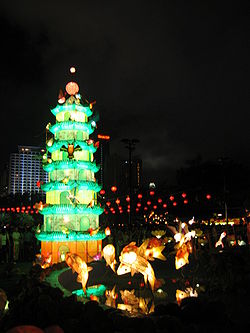Mid-Autumn Festival
The Mid-Autumn Festival or the Moon Festival or the Mooncake Festival is a traditional festival celebrated in mainland China, Taiwan, Hong Kong, Macau, and Vietnam, as well as by overseas Chinese and Vietnamese people. Similar holidays are celebrated in Japan, Korea, and across many Southeast Asian regions.[1]
It is one of the most important holidays in Chinese culture. Its popularity is at the same level with that of Chinese New Year. The history of the Mid-Autumn Festival dates back to 3,000 years back.[2][3] The festival is held on the 15th day of the 8th month of the Chinese lunisolar calendar. It is celebrated in a full moon night. It is during the mid-September to early October according to the Gregorian calendar.[4] On this day, the Chinese believe that the moon is at its brightest and fullest size. This coincides with the harvesting time in the middle of Autumn.[5]
Lanterns of all sizes and shapes, are carried and displayed. This symbolises that light brings people's way to prosperity and good luck. Mooncakes, are traditionally eaten during this festival. These are mostly filled with sweet-bean, egg yolk, meat or lotus-seed paste.[6][7][8] The Mid-Autumn Festival is based on the story of Chang'e, the moon goddess in Chinese mythology.
Celebrations
Moon worship
- Further information: Chang'e
An important part of the festival celebration is Moon worship. The ancient Chinese people believed in renewing associated with the Moon and water. This concept is related to the menstruation of women. So, they called it "monthly water".[9]
Lanterns
A very important part of celebrating the festival is carrying the bright lanterns and lighting them on towers or floating sky lanterns.[4] Another tradition involving lanterns is to write riddles on them and have other people try to guess the answers (simplified Chinese: 灯谜; traditional Chinese: 燈謎; pinyin: dēng mí; literally "lantern riddles").[10][11]
Lantern usages were not combined with Moon-worship before the Tang dynasty.[11] Traditionally, the lantern has been used to represent fertility. The laterns act mainly as a toy and decoration. But today the lantern has come to depict the festival itself.[11] In the old days, lanterns were made in the image of natural things, myths and local cultures.[11] As time passed, a greater variety of lanterns could be found as local cultures became influenced by their neighbors.[11]
As China gradually evolved from a farming society to a mixed farming and trading one, traditions from other festivals began to be brought into the Mid-Autumn Festival. For example, the putting of lanterns on rivers to help the souls of the drowned as practiced during the Ghost Festival.[11] During the Qing dynasty, Hong Kong fishermen would put up lanterns on their boats for the Ghost Festival. They keep the lanterns up until Mid-Autumn Festival.[11]
Mid-Autumn Festival Media
Lantern in Senado Square, Macau
Autumn Moon Festival in San Francisco Chinatown, 2007
References
- ↑ "Explained: What is the Mid-Autumn Festival all about and how is it celebrated?". The Indian Express. 2019-09-14. Retrieved 2021-11-28.
- ↑ Moon Festival – The Chinese Mid Autumn Festival. 3 June 2021. https://moonfestivalblog.com/moon-festival-the-chinese-mid-autumn-festival/. Retrieved 28 November 2021.
- ↑ Roy, Christian (2005). Traditional Festivals: A Multicultural Encyclopedia, Volume 1. ABC-CLIO. pp. 282–286. ISBN 978-1576070895.
- ↑ 4.0 4.1 Yang, Fang. Mid-Autumn Festival and its traditions. http://news.xinhuanet.com/english2010/culture/2011-09/12/c_131134150.htm. "The festival, celebrated on the 15th day of the eighth month of the Chinese calendar, has no fixed date on the Western calendar, but the day always coincides with a full moon.".
- ↑ "Mooncakes, lanterns and legends: Your guide to the Mid-Autumn Festival in Singapore". AsiaOne. 19 September 2020. https://www.asiaone.com/lifestyle/mooncakes-lanterns-and-legends-your-guide-mid-autumn-festival-singapore.
- ↑ "Mid-Autumn Festival in Other Asian Countries". www.travelchinaguide.com. https://www.travelchinaguide.com/essential/holidays/mid-autumn-asia.htm.
- ↑ "A Chinese Symbol of Reunion: Moon Cakes – China culture" (in en). kaleidoscope.cultural-china.com. http://kaleidoscope.cultural-china.com/en/8Kaleidoscope562.html. Retrieved 4 October 2017.
- ↑ Back to Basics: Baked Traditional Moon Cakes. 10 August 2014. https://kwgls.wordpress.com/2014/08/10/back-to-basicsbaked-traditional-mooncake-%E4%BC%A0%E7%BB%9F%E7%B2%A4%E5%BC%8F%E6%9C%88%E9%A5%BC%EF%BC%89/. Retrieved 4 October 2017.
- ↑ Li, Xing (2006). "Chapter VI: Women's Festivals". Festivals of China's Ethnic Minorities. China Intercontinental Press. pp. 124–127. ISBN 978-7508509990.
- ↑ Yang, Lemei (Sep–Dec 2006). "China's Mid-Autumn Day". Journal of Folklore Research. 43 (3): 263–270. doi:10.2979/jfr.2006.43.3.263. JSTOR 4640212. S2CID 161494297.
- ↑ 11.0 11.1 11.2 11.3 11.4 11.5 11.6 Siu, K. W. Michael (1999). "Lanterns of the mid-Autumn Festival: A Reflection of Hong Kong Cultural Change". The Journal of Popular Culture. 33 (2): 67–86. doi:10.1111/j.0022-3840.1999.3302_67.x.










